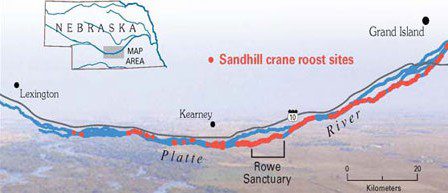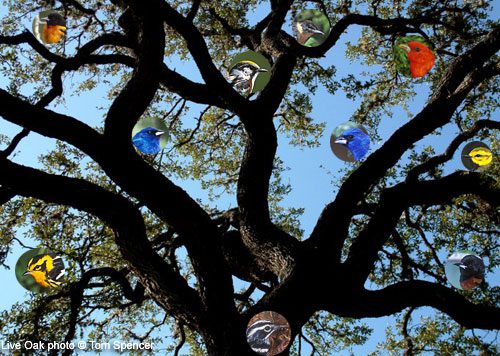How Long Does It Take a Baby Bird to Fly
Originally published January 2007; updated August 2021.

Geese winging their mode s in wrinkled V-shaped flocks is peradventure the classic movie of migration—the annual, large-scale movement of birds between their breeding (summertime) homes and their nonbreeding (wintertime) grounds. Simply geese are far from our just migratory birds. Of the more than 650 species of North American breeding birds, more than half are migratory.
Why exercise birds drift?
Birds drift to move from areas of low or decreasing resources to areas of high or increasing resources. The 2 primary resources being sought are food and nesting locations. Here's more about how migration evolved.
Birds that nest in the Northern Hemisphere tend to migrate northward in the spring to have advantage of burgeoning insect populations, budding plants and an abundance of nesting locations. As winter approaches and the availability of insects and other food drops, the birds move south again. Escaping the common cold is a motivating factor but many species, including hummingbirds, can withstand freezing temperatures as long equally an adequate supply of nutrient is available.
Types of migration
The term migration describes periodic, big-calibration movements of populations of animals. One way to wait at migration is to consider the distances traveled.
The blueprint of migration tin vary inside each category, merely is most variable in short and medium distance migrants.
Origins of long-altitude migration
While short-distance migration probably developed from a fairly unproblematic need for nutrient, the origins of long-distant migration patterns are much more complex. They've evolved over thousands of years and are controlled at least partially by the genetic makeup of the birds. They likewise contain responses to weather, geography, food sources, 24-hour interval length, and other factors.
For birds that winter in the torrid zone, it seems foreign to imagine leaving habitation and embarking on a migration north. Why make such an backbreaking trip north in spring? Ane idea is that through many generations the tropical ancestors of these birds dispersed from their tropical convenance sites north. The seasonal abundance of insect food and greater twenty-four hour period length allowed them to raise more than young (4–6 on average) than their stay-at-home tropical relatives (2–iii on average). As their convenance zones moved northward during periods of glacial retreat, the birds connected to render to their tropical homes as winter weather and declining food supplies made life more than difficult. Supporting this theory is the fact that nigh North American vireos, flycatchers, tanagers, warblers, orioles, and swallows accept evolved from forms that originated in the tropics.
What triggers migration?
The mechanisms initiating migratory behavior vary and are not always completely understood. Migration tin can be triggered past a combination of changes in day length, lower temperatures, changes in food supplies, and genetic predisposition. For centuries, people who have kept cage birds have noticed that the migratory species go through a menstruation of restlessness each spring and fall, repeatedly fluttering toward ane side of their cage. German behavioral scientists gave this behavior the name zugunruhe, meaning migratory restlessness. Dissimilar species of birds and even segments of the population within the same species may follow unlike migratory patterns.
How do birds navigate?
Migrating birds can encompass thousands of miles in their annual travels, often traveling the aforementioned class year afterward year with footling deviation. First-yr birds often make their very start migration on their ain. Somehow they tin can find their winter home despite never having seen it before, and return the following spring to where they were born.
The secrets of their amazing navigational skills aren't fully understood, partly considering birds combine several different types of senses when they navigate. Birds can get compass information from the dominicus, the stars, and by sensing the earth's magnetic field. They too get information from the position of the setting sun and from landmarks seen during the day. There'due south even evidence that sense of smell plays a role, at least for homing pigeons.
Some species, particularly waterfowl and cranes, follow preferred pathways on their annual migrations. These pathways are oft related to important stopover locations that provide nutrient supplies critical to the birds' survival. Smaller birds tend to migrate in wide fronts across the landscape. Studies using eBird data have revealed that many small birds have different routes in spring and autumn, to take reward of seasonal patterns in weather condition and food.
Migration hazards
Taking a journeying that can stretch to a round-trip distance of several thousand miles is a dangerous and arduous undertaking. Information technology is an try that tests both the birds' physical and mental capabilities. The physical stress of the trip, lack of adequate nutrient supplies along the mode, bad weather, and increased exposure to predators all add to the hazards of the journey.
In recent decades long-afar migrants have been facing a growing threat from communication towers and tall buildings. Many species are attracted to the lights of tall buildings and millions are killed each year in collisions with the structures. The Fatal Calorie-free Awareness Plan, based in Toronto, Ontario, Canada, and BirdCast'south Lights Out project, take more about this problem.
Studying migration

Each spring, virtually 500,000 Sandhill Cranes and some endangered Whooping Cranes use Nebraska's Platte River as a staging habitat during their northward migration.
Scientists use several techniques in studying migration, including banding, satellite tracking, and a relatively new method involving lightweight devices known equally geolocators. One of the goals is to locate of import stopover and wintering locations. Once identified, steps tin can be taken to protect and save these key locations.
Each spring approximately 500,000 Sandhill Cranes and some endangered Whooping Cranes use the Central Platte River Valley in Nebraska every bit a staging habitat during their migration north to breeding and nesting grounds in Canada, Alaska, and the Siberian Arctic.
What is a migrant trap?

Giant alive oak copse, like these in High Island, Texas, concenter many of our nigh cute birds after their leap journey beyond the Gulf of Mexico. Clockwise from top left: Baltimore Oriole, Indigo Bunting, Chestnut-sided Warbler, Bay-breasted Warbler, Blue Grosbeak, Scarlet Tanager, Black-throated Green Warbler, Orchard Oriole, Black-and-white Warbler, Blackburnian Warbler.
Some places seem to take a knack for concentrating migrating birds in larger than normal numbers. These "migrant traps" frequently go well known equally birding hotspots. This is typically the result of local conditions conditions, an affluence of food, or the local topography.
For example, modest songbirds migrating north in the spring fly straight over the Gulf of Mexico, landing on the coastlines of the Gulf Declension states. When, storms or cold fronts bring headwinds, these birds tin exist near exhaustion when they reach country. In such cases they head for the nearest location offering food and comprehend—typically alive-oak groves on bulwark islands, where very large numbers of migrants tin collect in what's known as a "fallout." These migration traps accept become very popular with birders, fifty-fifty earning international reputations.
Peninsulas tin also concentrate migrating birds every bit they follow the land and then pause before launching over water. This explains why places similar Point Pelee, Ontario; the Florida Keys; Indicate Reyes, California; and Cape May, New Jersey have great reputations as migration hotspots.
Jump migration is an especially good time for those that feed birds in their backyard to concenter species they normally do not see. Offer a variety of food sources, water, and adding natural food sources to the mural can brand a backyard attractive to migrating songbirds.
Range maps
'vimeo-'
It'due south always a good thought to use the range maps in your field guide to make up one's mind if and when a detail species might be around. Range maps are especially useful when working with migratory species. However, they tin be confusing: ranges of birds can vary year-to-yr, as with irruptive species such as redpolls. Also, the ranges of some species tin expand or contract fairly rapidly, with changes occurring in time periods shorter than the republication time of a field guide. (The Eurasian Collared-Dove is the best example of this problem.)
These limitations are showtime to be addressed past data-driven, digital versions of range maps. The maps are made possible by the hundreds of millions of eBird observations submitted by birdwatchers around the world. "Big Information" analyses are allowing scientists to produce animated maps that show a species' ebb and flow across the continent throughout a calendar year—every bit well as understand larger patterns of movement.
Additional resources
Migration is a fascinating report and in that location is much yet to acquire. Songbird Journeys, by the Cornell Lab's Miyoko Chu, explores many aspects of migration in an interesting and easy-to-read mode. The Cornell Lab's Handbook of Bird Biology provides even more data on the astonishing phenomenon of bird migration.
bratchersubmiliand.blogspot.com
Source: https://www.allaboutbirds.org/news/the-basics-how-why-and-where-of-bird-migration/
Post a Comment for "How Long Does It Take a Baby Bird to Fly"